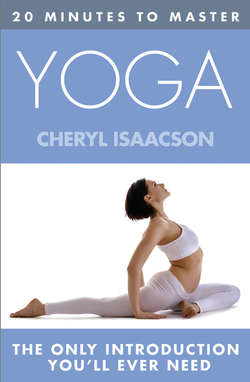Читать книгу 20 MINUTES TO MASTER ... YOGA - Cheryl Isaacson - Страница 13
ОглавлениеCHAPTER 5
GETTING PHYSICAL – DOING THE POSTURES
GETTING STARTED
It is not easy keeping to any practice routine at home. But it may be easier than dragging yourself out to a class on cold winter nights. However, you do have to practise. It is the only way you will benefit. Regular and consistent work pays off. Even if you go to classes, it pays to supplement what you do there with some daily practice.
The good news is that you do not have to do that much. Not everyone is dedicated enough to get up at the crack of dawn every day to practise. Try and make your yoga practice work for you, so it becomes something you enjoy. Do it with a friend or in office lunch hours, or make it part of your routine when you get back from work.
WHEN TO PRACTISE
There are ten exercises listed here – that’s a short routine, which you should be able to fit into the day. The whole session should not take longer than 45 minutes. You will take more time at first, while you are learning. In time you will find you feel ‘not quite right’ on the days you don’t practise. Your body will start to need yoga!
You can divide the practice up into separate times during the day. Maybe do the warming up and the cat pose first thing in the morning; the standing postures at midday; the sitting postures late afternoon; and the spinal twist and the shoulderstand before going to bed. That makes ten to fifteen minutes a session – which should be achievable! If you decide to practise in separate sessions, begin each one with a short relaxation, breathing and warming up exercises.
BEFORE YOU START
There are certain practical things to bear in mind:
If you have a medical condition, you should only train with a properly qualified yoga teacher, and consult your doctor first.
If you are pregnant, do not start a yoga programme as a beginner. Consult a yoga teacher and only continue if you know what you are doing.
During menstruation, listen to your body. You may need to rest completely from yoga postures for the first couple of days. Do not do any inverted postures during your period.
Do not eat beforehand – three hours for a meal, two hours for a snack.
If possible, have bowels and bladder empty.
Wear loose clothing that you can move freely in.
Feet should be bare. The floor can be carpeted but make sure you can have a firm grip – no deep pile. A specialized yoga mat is important. It prevents your feet slipping and the thicker ones give support.
Make sure the practice room is warm and that you don’t get chilled – have spare clothing to hand if necessary.
FIRST – RELAX!
All yoga sessions should start with a brief relaxation. Lie on the floor, stretch your arms and feet out to the sides. Wriggle your back around on the floor, easing any tension. Now bend your knees, with feet on the floor close to the buttocks. Take the back of the head in the hands, lift it slightly and ease out the back of the neck. Make sure your neck feels long as you replace your head on the floor, with the chin tucked slightly downwards. Replace the arms on the floor, at a 45-degree angle from the sides of your body, the palms of your hands facing upwards. Feel as if your whole spine is dropping towards the floor. Feel the contact of all the vertebrae with the floor.
